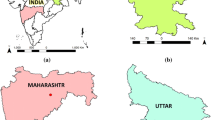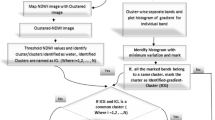Abstract
Some techniques and methods for deriving water information from SPOT-4(XI) image were investigated and discussed in this paper. An algorithm of decision-tree (DT) classification which includes several classifiers based on the spectral responding characteristics of water bodies and other objects, was developed and put forward to delineate water bodies. Another algorithm of decision-tree classification based on both spectral characteristics and auxiliary information of DEM and slope (DTDS) was also designed for water bodies extraction. In addition, supervised classification method of maximum-likelyhood classification (MLC), and unsupervised method of interactive self-organizing dada analysis technique (ISODATA) were used to extract waterbodies for comparison purpose. An index was designed and used to assess the accuracy of different methods adopted in the research. Results have shown that water extraction accuracy was variable with respect to the various techniques applied. It was low using ISODATA, very high using DT algorithm and much higher using both DTDS and MLC.
Similar content being viewed by others
References
BARTON I J, Bathols J M, 1989. Mornitoring floods with AVHRR[J]. Remote Sensing of Environment, 30 (1): 89–94.
DU Yun-yan, ZHOU Cheng-hu, 1998. Automatically Extracting Remote Sensing Information for Waterbodies[J]. Remote Sensing of Environment, 2(4): 264–268. (in Chinese)
LIU Jian-bo, DAI Chang-da, 1996. The Application of TM Image in Reservoir Situation Monitoring[J]. Remote Sensing of Environment, 11(1): 53–58. (in Chinese)
LU Jia-ju, LI Shi-hong, 1992. Improvement of the Techniques for Distinguishing Water Bodies from TM Data[J]. Remote Sensing of Environment, 7(1):17–23. (in Chinese)
SHENG Yong-wei, XIAO Qian-guang, 1994. Waterbody Identification in Cloud-Contaminated NOAA/AVHRR Image[J]. Remote Sensing of Environment, 9(4): 247–255. (in Chinese)
SHIH S F, 1985. Comparison of ELAS classifications and density slicing Landsat data for water surface area assessment[A]. In: JOHNSON A I (ed). Hydrologic Applications of Space Technology (Publication No. 160)[C]. Wallingford: IAHS Press, 91–97.
XIAO Qian-guang, et al., 1987. NOAA Imagery Application for Monitoring Songhua River Flood[J]. Remote Sensing Information, (4): 26–27. (in Chinese)
YANG Cun-jian, Xu Mei, 1998. Investigation on Extracting the Waterbody from Landsat TM[J]. Geographical Research, 17 (supplement): 86–89. (in Chinese)
ZHOU Cheng-hu, DU Yun-yan, LUO Jian-cheng, 1996. A Description Model Based on Knowledge for Automatically Recognizing Water from NOAA/AVHRR[J]. Journal of Natural Disasters, 5(3): 100–108. (in Chinese)
Author information
Authors and Affiliations
Additional information
Biography: DU Jin-kang(1964 –), male, a native of Muping County, Shandong Province, associate professor. His research interests include hydrological modeling, application of GIS and Remote Sensing to hydrology.
Rights and permissions
About this article
Cite this article
Du, Jk., Feng, Xz., Wang, Zl. et al. The methods of extracting water information from spot image. Chin. Geograph.Sc. 12, 68–72 (2002). https://doi.org/10.1007/s11769-002-0073-1
Received:
Issue Date:
DOI: https://doi.org/10.1007/s11769-002-0073-1




